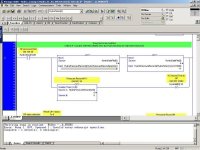Hi everyone,
I am in process of converting one of our lines from RS5 (PLC5) to control logix (RS5000), and its going pretty good, but I got to the point that I am not sure how to solve one small problem.
I submit the way it was done in RS5.
Really simple and elegant. Instruction MOV would start filing #N50:[T34:36.ACC] where this timer is set with 1 second time base.
This in turn mean that every time when this timer's ACC change, a new value would be recorded in next location.
SInce there is no more time bases of 1 second, this means I need to change the original logic. I am kind of inclined to simplify our older and more complex problems so I really hesitate to change this to what it seems as my only solution.
That would involve including another timer (triggered by the original one), set to time out every second, whose DN bit would trigger a counter...and you all can see where all this goes.
Another question is can I keep the MOV instruction, or do I have to use File Fill ? I am asking this, since in RS5, if I put prefix # before the destination in MOV, the program would automaticaly knew.
# does not work in RS5000, and I am afraid that I would be getting new value over writing the old one with every new refresh.
Thanks a lot,
Darko
I am in process of converting one of our lines from RS5 (PLC5) to control logix (RS5000), and its going pretty good, but I got to the point that I am not sure how to solve one small problem.
I submit the way it was done in RS5.
Really simple and elegant. Instruction MOV would start filing #N50:[T34:36.ACC] where this timer is set with 1 second time base.
This in turn mean that every time when this timer's ACC change, a new value would be recorded in next location.
SInce there is no more time bases of 1 second, this means I need to change the original logic. I am kind of inclined to simplify our older and more complex problems so I really hesitate to change this to what it seems as my only solution.
That would involve including another timer (triggered by the original one), set to time out every second, whose DN bit would trigger a counter...and you all can see where all this goes.
Another question is can I keep the MOV instruction, or do I have to use File Fill ? I am asking this, since in RS5, if I put prefix # before the destination in MOV, the program would automaticaly knew.
# does not work in RS5000, and I am afraid that I would be getting new value over writing the old one with every new refresh.
Thanks a lot,
Darko




